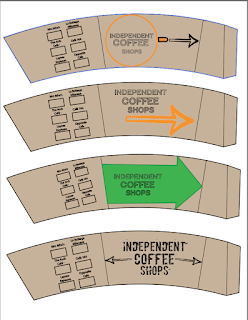The visual language of this signage system is arguably a combination of both objective and subjective design. Independent coffee shops have a very personal feel and exist as individual particular places and with my system diverting people away from chain coffee shops it is arguably subjective. However, objectively, it directs people to the nearest coffee shop opposed to directing someone to a specified coffee shop, opinion on the quality of each coffee shop is removed therefore displaying no hierarchy.
The design itself only uses 3 flat colours brown, black and red. There is no text and features symbolism of coffee this causes it to be objectively understood by whoever. However other aesthetics, such as the materials used to build my sign (carboard) and the process being freehand without a grid, are uncommon in other objective sign systems and therefore the design becomes particular.
With my design being used as actual coffee sleeves in the coffee shops as well as a signage system on the streets, it links up my system and helps it become better understood as well touching on being part of a community. It also allows people to keep the design if they like it and easily becomes distributed within Leeds.
Van Toorn however led the dissent against the ‘objective’ approach. Toorn agues passionately for the importance of designers retaining a sense of personality and romance in graphic design in his statement, “in fine art, experiments have been done for centuries, and perhaps we should pick up more from that tradition and use more form it”.
Graphic designer Wim Crouwel, opposes Toorns argument, in his belief of graphic design being objectively built on clarity and simplicity with use of grids. Staying true to his original viewpoint of “I have always believed that graphic design is a discipline that should translate a message in an aesthetic and straight forward way, without personal interpretation that has no connection with that message.”





















